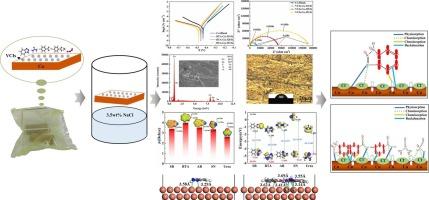Corrosion inhibition mechanism of copper by a novel benzotriazole-based multicomponent volatile corrosion inhibitors packaging film: Surface characterization and theoretical analysis
IF 4.3
2区 工程技术
Q2 ENGINEERING, CHEMICAL
引用次数: 0
Abstract
Investigating the synergistic effects of multi-component complex formulation corrosion inhibitors is crucial for achieving optimal protection of metals against corrosion. The corrosion inhibition behaviors of benzotriazole(BTA) film and volatile corrosion inhibitors(VCIs) film on copper in a 3.5 wt% NaCl solution were systematically analyzed by weight loss tests, electrochemical analyses, FTIR, XRD, 3D electron microscopy, contact angle tests and SEM. Moreover, the synergistic effects between VCIs were illustrated molecularly by DFT and MD calculations. The findings revealed that the high corrosion inhibition efficiency was contingent upon the parallel adsorption orientations of VCIs, as well as the mixed physisorption and chemisorption mechanism. The corrosion inhibition effect of VCIs film on Cu was superior to that of BTA film, and the synergistic effect of the complex formulation VCIs was further confirmed by a higher adsorption energy and a denser parallel adsorption structure. VCIs demonstrated a favorable ability to form a protective film on the copper surface, with the efficacy increasing with the temperature of the inhibitor films formation treatment. The VCIs in the novel BTA multicomponent corrosion inhibitor packaging film functioned as mixed-type inhibitors, primarily inhibiting the cathodic reaction. This study holds significant importance in unraveling the mechanisms of the corrosion behavior regulated by VCIs.

新型苯并三唑多组分挥发性缓蚀剂包装膜对铜的缓蚀机理:表面表征与理论分析
研究多组分复合配方缓蚀剂的协同效应对于实现最佳的金属抗腐蚀保护至关重要。采用失重试验、电化学分析、FTIR、XRD、3D电镜、接触角测试和扫描电镜等方法,系统分析了苯并三唑(BTA)膜和挥发性缓蚀剂(VCIs)膜在3.5 wt% NaCl溶液中对铜的缓蚀行为。此外,通过DFT和MD计算,从分子角度说明了vci之间的协同效应。研究结果表明,高缓蚀效率取决于vci的平行吸附取向,以及物理吸附和化学吸附的混合机制。VCIs膜对Cu的缓蚀效果优于BTA膜,而更高的吸附能和更致密的平行吸附结构进一步证实了复合配方VCIs的协同作用。vci表现出良好的在铜表面形成保护膜的能力,并且随着保护膜形成处理温度的增加,保护膜的效果也在增加。新型BTA多组分缓蚀剂包装膜中的vci作为混合型缓蚀剂,主要抑制阴极反应。该研究对于揭示vci调控腐蚀行为的机制具有重要意义。
本文章由计算机程序翻译,如有差异,请以英文原文为准。
求助全文
约1分钟内获得全文
求助全文
来源期刊

Chemical Engineering Science
工程技术-工程:化工
CiteScore
7.50
自引率
8.50%
发文量
1025
审稿时长
50 days
期刊介绍:
Chemical engineering enables the transformation of natural resources and energy into useful products for society. It draws on and applies natural sciences, mathematics and economics, and has developed fundamental engineering science that underpins the discipline.
Chemical Engineering Science (CES) has been publishing papers on the fundamentals of chemical engineering since 1951. CES is the platform where the most significant advances in the discipline have ever since been published. Chemical Engineering Science has accompanied and sustained chemical engineering through its development into the vibrant and broad scientific discipline it is today.
 求助内容:
求助内容: 应助结果提醒方式:
应助结果提醒方式:


